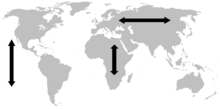Rich and poor (diamond)
Rich and poor - The fates of human societies ( Guns, Germs, and Steel: The Fates of Human Societies ) is the title of a non-fiction book by the American author Jared Diamond , which was awarded the Pulitzer Prize in 1998.
Basic thesis
In the work the author develops the comprehensive theory of geographical determinism . The starting point is the question of why human societies, which all lived as hunters and gatherers around 13,000 years ago, have developed very differently since then. It is emphasized that there are by no means superior and inferior races, but only different conditions in terms of geography , climate , flora and fauna of the continents explain the differences in development.
Development requirements in Eurasia
The emergence of arable farming and cattle breeding in Mesopotamia was therefore possible because in this then temperate climatic zone with distinct seasons a number of domesticable wild plants such as peas, wheat and barley grew, whose relatively large fruits and grains could be stored for a long time due to the species' ability to hibernate. Similar favorable conditions existed for the domestication of larger mammals, especially for those of cattle and horses, which, in addition to their function as milk and meat suppliers, could also be used as draft and transport animals.
This made it possible to generate a food surplus, which in turn enabled an increase in population, the emergence of sedentarism , crafts , innovations and technologies such as metalworking and societies based on the division of labor. This led to the development of cities, which in turn entailed complex political systems, social hierarchies, administration and the development of writing. The larger number of people, combined with superior weapon technology and better organization, led to the displacement or adaptation of neighboring hunter-gatherer societies. The contiguous land mass of Eurasia, with similar climatic zones and without major, inevitable geographical barriers such as deserts and mountains, enabled a rapid expansion of these achievements both in western and eastern directions.
The coexistence of many people and animals in a confined space enabled the development of epidemics such as smallpox , plague and tuberculosis , the pathogens of which were originally transmitted from animals to humans. These requirements were not met in hunter-gatherer societies. Over the millennia, however, the Eurasian societies developed resistance to these epidemics.
In contrast to China, the fragmented geography of Europe prevented the emergence of larger empires and led to competition, which in turn favored the development of weapons technology and political systems.
Development requirements in other parts of the world
Many of these prerequisites were not or only partially given in other parts of the world, so that corresponding developments outside of the Eurasian land mass did not take place at all or took place more slowly and inefficiently. For example, domesticable animals in North America were exterminated by Stone Age hunters. The north-south orientation and the geography of the American continent, in turn, prevented the spread of domesticated plants from temperate latitudes , as tropical zones, the Isthmus of Panama and the deserts in southern North America acted as natural barriers. In the other continents, such as Africa and Australia, basic requirements were missing from the outset, such as the existence of domesticable animals, paired with unfavorable geographical and climatic conditions (Australia) and the disadvantageous north-south axis with tropical zones in between (Africa).
Dominance of Western Societies
When Europeans systematically explored and settled the non-Eurasian continents from the 15th century onwards, they had a vastly superior war technique and political organization that enabled them to quickly subjugate native societies. For example, the Inca Empire was destroyed by only 160 Spaniards in a short time.
Diamond explains that, in addition to the superior weapon technology, it was in particular the diseases brought in by the Europeans that often wiped out over 90 percent of the native population, so that germs actually became the most important factor in the subjugation and decimation of indigenous peoples. With a few exceptions, pathogens from the subjugated continents could not achieve the same effect on the invaders, as they were able to develop much stronger resistances in their development history.
expenditure
- Rich and poor. The fates of human societies . S. Fischer, Frankfurt am Main 1998, ISBN 3-10-013903-8 .
- Rich and poor. The fates of human societies . Fischer-Taschenbuch-Verlag, Frankfurt am Main 2002, ISBN 3-596-14967-3 .
- Rich and poor. The fates of human societies . Extended new edition. Fischer-Taschenbuch-Verlag, Frankfurt am Main 2011, ISBN 3-596-17214-4 .
- Guns, Germs and Steel. The fates of human societies . Norton Publishing, New York 1997, ISBN 0-393-03891-2 .
- Guns, Germs and Steel. The fates of human societies - with a new chapter on Japan . Norton Publisher, New York 2005, ISBN 0-393-06131-0 .

